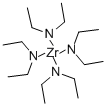
IdentificationPhysical DataSpectraRoute of Synthesis (ROS)Safety and HazardsOther Data
Identification
Product NameTETRAKIS(DIETHYLAMINO)ZIRCONIUMIUPAC Namediethylazanide;zirconium(4+) Molecular StructureCAS Registry Number 13801-49-5SynonymsTetrakis(diethylamino)zirconium13801-49-5diethylazanide;zirconium(4+)Tetrakis(diethylamino) zirconium(IV)Zirconium, tetrakis(diethylamino)-Tetrakis(diethylamido)zirconium(IV)MFCD00015649SCHEMBL77355tetrakis(diethylamido)zirconiumzirconium tetra(diethyl amide)GOVWJRDDHRBJRW-UHFFFAOYSA-NAKOS025243719CS-0111450Ethanamine, N-ethyl-, zirconium(4+) salt (4:1)Tetrakis(diethylamido)zirconium(IV), electronic grade, >=99.99% trace metals basisMolecular FormulaC16H40N4ZrMolecular Weight379.74InChIInChI=1S/4C4H10N.Zr/c4*1-3-5-4-2;/h4*3-4H2,1-2H3;/q4*-1;+4InChI KeyGOVWJRDDHRBJRW-UHFFFAOYSA-NIsomeric SMILESCCCC.CCCC.CCCC.CCCC.
Physical Data
AppearanceLight yellow liquid
Spectra
Description (NMR Spectroscopy)Nucleus (NMR Spectroscopy)Solvents (NMR Spectroscopy)Chemical shifts, Spectrum1HpyridineChemical shifts, Spectrum13Cpyridine
Description (IR Spectroscopy)Solvent (IR Spectroscopy)Intensity of IR bands, Bands, Spectrumpotassium bromide
Route of Synthesis (ROS)
Route of Synthesis (ROS) of TETRAKIS(DIETHYLAMIDO)ZIRCONIUM CAS 13801-49-5
ConditionsYieldIn pentane at -30℃; for 12h; Inert atmosphere;Experimental Procedure2.3. Synthesis of Zr(NEt2)22 (2)Zr(NEt2)4 (2.344 g, 6.171 mmol) in pentane (50 mL) at 30 °C was added dropwise with stirring iPrN(H)C(Me) = NiPr (1.761 g, 12.38 mmol) in pentane (50 mL). The solution was stirred for 12 h and volatiles removed in vacuo affording an analytically pure yellow solid of 2 (2.954 g, 5.702 mmol, 92.4% yield). 1H NMR (benzene-d6, 400.17 MHz, 23 °C ): δ 3.71 (br, 8H, N(CH2CH3)2), 3.46(br, 4H, CHMe2), 1.59 (s, 6H, NC(Me)N), 1.20 (br, 24H, CHMe2),1.10 (t, 12H, N(CH2CH3)2). 13C{1H} NMR (benzene-d6,100.62 MHz, 23 °C ): δ 173.35 (NC(Me)N), 48.04 (CHMe2), 41.67(N(CH2CH3)2), 25.62 (CHMe2), 13.69 (N(CH2CH3)2), 11.90(NC(Me)N). 1H NMR (toluene-d8, 400.08 MHz, 23 °C ): δ 3.68 (br,8H, N(CH2CH3)2), 3.46 (br, 4H, CHMe2), 1.61 (s, 6H, NC(Me)N),1.26 (br, 24H, CHMe2), 1.09 (t, 12H, N(CH2CH3)2). 13C{1H} NMR(toluene-d8, 100.60 MHz, 23 °C ): δ 172.64 (NC(Me)N), 48.27 (br,CHMe2), 41.65 (N(CH2CH3)2), 25.67 (br, CHMe2), 13.68 (N(CH2-CH3)2), 11.81 (NC(Me)N). 1H NMR (toluene-d8, 400.08 MHz,60 °C ): δ 3.95 (m, 4H, N(CH2CH3)2), 3.62 (m, 4H, N(CH2CH3)2),3.47 (m, 2H, CHMe2), 3.32 (m, 2H, CHMe2), 1.53 (s, 6H, NC(Me)N),1.42 (d, 6H, CHMe2), 1.36 (d, 6H, CHMe2), 1.14 (d, 6H, CHMe2),1.13 (d, 6H, CHMe2), 1.13 (t, 12H, N(CH2CH3)2). 13C{1H} NMR(toluene-d8, 100.60 MHz, 60 °C ): δ 173.14 (NC(Me)N), 48.15(CHMe2), 47.55 (CHMe2), 41.11 (N(CH2CH3)2), 25.93 (CHMe2),25.91 (CHMe2), 25.53 (CHMe2), 23.52 (CHMe2), 13.30 (N(CH2CH3)2),11.27 (NC(Me)N). The 1H and 13C{1H} NMR assignments were confirmedby HMBC (23 C) and HSQC (213 K) experiments. Anal.Calcd: C, 55.65; H, 10.51; N, 16.23. Found: C, 55.49; H, 10.40; N,16.17.92.4%
Safety and Hazards
Pictogram(s)SignalDangerGHS Hazard StatementsH225 (93.85%): Highly Flammable liquid and vapor H226 (40%): Flammable liquid and vapor H261 (60%): In contact with water releases flammable gas H314 (41.54%): Causes severe skin burns and eye damage H315 (58.46%): Causes skin irritation H319 (58.46%): Causes serious eye irritation H335 (100%): May cause respiratory irritation Precautionary Statement CodesP210, P231+P232, P233, P240, P241, P242, P243, P260, P261, P264, P264+P265, P271, P280, P301+P330+P331, P302+P352, P302+P361+P354, P303+P361+P353, P304+P340, P305+P351+P338, P305+P354+P338, P316, P319, P321, P332+P317, P337+P317, P362+P364, P363, P370+P378, P402+P404, P403+P233, P403+P235, P405, and P501(The corresponding statement to each P-code can be found at the GHS Classification page.)
Other Data
No data available
DruglikenessLipinski rules componentMolecular Weight379.744HBA1HBD0Matching Lipinski Rules3Veber rules componentPolar Surface Area (PSA)0Rotatable Bond (RotB)0Matching Veber Rules2
Use PatternTETRAKIS(DIETHYLAMIDO)ZIRCONIUM CAS 13801-49-5 may be used as a precursor for synthesizing other zirconium compounds. By employing appropriate reaction conditions, it is possible to synthesize zirconium compounds with different properties.
https://www.chemwhat.com/tetrakisdiethylaminozirconium-cas-13801-49-5/
Comments
Post a Comment